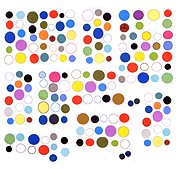"Massive Spring Forward" [mp3 removed -- a newer version is available on Bandcamp]
All done in Octatrack sequencer. The main beats are an Electribe Rmk II riff sampled, sliced, and reorganized. The basses and synths are .wav files I've been recycling in recent tracks, with speed and length settings altered (or not) and some added effects.
Loosely inspired by the mod tracker techno I've been listening to. The Octatrack is hardware but certain aspects of its design are very tracker-like, particularly the "arranger," which has a list view of patterns that is paged down at whatever tempo you set (in this case 172 bpm). Also these samples, massaged as much as they are, are not exactly artifact-free. The piquant hint of cement mixer rumble can be heard at high volume but most of the tunes I'm doing I listen to fairly quietly.
The hyperactive synth solo at the end wasn't working for me until I added a sample with three notes -- these triplets are played at superhuman speed and are sort of arpeggio-like. The synth snippet was taken from Reaktor's Oki Computer 2 and reminds me of an 8-Bit sax.
